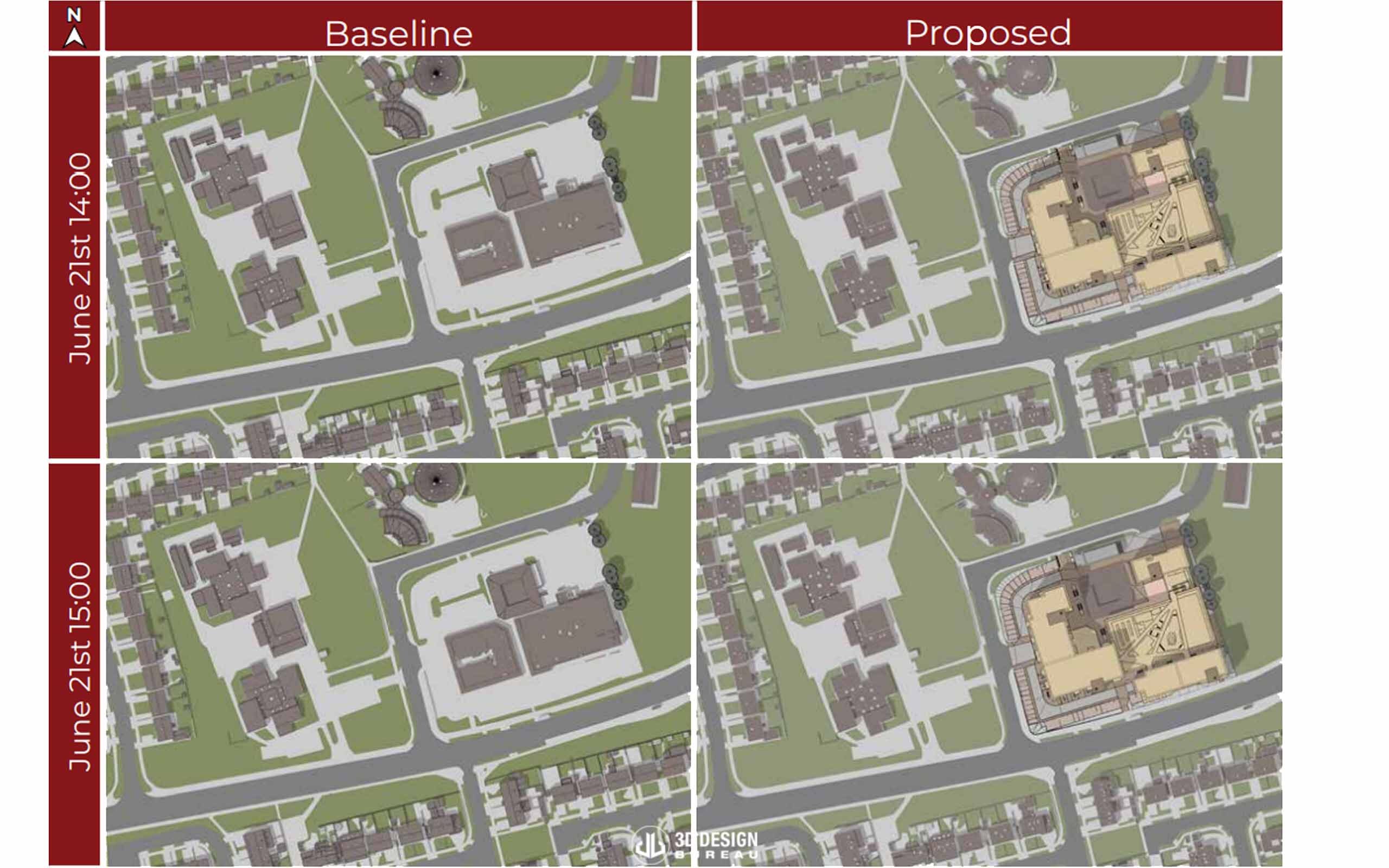This blog takes a deep dive into the metrics assessed for Scheme Performance under the latest edition of the BRE Guidelines. If you are new to Daylight and Sunlight Assessments, we suggest that you first read Daylight & Sunlight Assessments: A Vital Component to Planning Applications. to understand the what? how? and why? and in turn, help you better understand the content below. All terminology is industry standard and should be used in daylight and sunlight assessment reports.
For information on ‘Impact Assessments’, visit All you need to know about Impact Assessments for the latest edition of BRE Daylight and Sunlight assessments

Let us help you secure planning
What metrics should be tested for scheme performance under the BRE Guidelines 2022?
The following are the main metrics of assessment for Scheme Performance under the BRE Guidelines for Daylight and Sunlight studies.
Sun On Ground in Proposed Outdoor Amenity Areas (SOG)
Sun on Ground for proposed outdoor amenity spaces for Scheme Performance needs to meet the same criteria as for SOG for Impact Assessment. The difference is that there is no comparison between the baseline and proposed model states.
The BRE Guidelines recommend that for a garden or amenity area to appear adequately sunlit throughout the year, at least half of it should receive at least two hours of sunlight on March 21st.
March 21st, also known as the spring equinox, is chosen as the assessment date as daytime and night-time are of approximately equal duration on this date.
The analytical model for SOG assessment in proposed amenity areas includes evergreen trees as per the BRE Guidelines. Typically, deciduous trees will not be included unless there is a particularly dense belt of them on our in close proximity to the subject site. See A professional take on Trees for Daylight and Sunlight assessments
A quantitative SOG assessment should be carried out on the areas of interested which should be indicated by the project architect or landscape architect. A shadow study and false color plans, which should be included as standard in all daylight and sunlight assessment reports, allow for a qualitative assessment of all other areas.
The portion of each assessed space capable of receiving 2 hours of direct sunlight on March 21st should be calculated individually. These areas can be combined to give the development average where appropriate.

Daylight, Spatial Daylight Autonomy in Proposed Habitable Rooms (SDA)
Since the publication of the 3rd edition of the BRE Guidelines (BRE 209 – 2022), Spatial Daylight Autonomy (SDA) is the recommended metric for assessing daylight access within a proposed development. Spatial Daylight Autonomy replaces Average Daylight Factor (ADF) in this regard, which was the recommended metric under the 2nd edition of the BRE Guidelines (BRE 209 – 2011).
Spatial Daylight Autonomy assesses whether a room receives sufficient daylight on a working plane during standard operating hours on an annual basis. A given target value should be achieved across 50% of the working plane for half of the daylight hours.
There are two methods for calculating SDA:
- Calculation method using illuminance level (SDA)
- Calculation method using daylight factor (MDF)
It is the opinion of 3DDB that the calculation method using illuminance level better represents a real-world scenario as it accounts for the quality of light based on orientation. As such, the illuminance level methodology has been adopted for all SDA assessments in our reports and uses a localised EnergyPlus Weather File (IRL_Dublin.039690_IWEC.epw) to apply the relevant climate information.
In terms of housing, BRE 209 provides target SDA values to be received across at least 50% of the working plane for at least half the daylight hours. The target values differ based on the function of the room assessed (unlike the IS-EN 17037 which does not specify room types):
- 200 Lux for kitchens
- 150 Lux for living rooms
- 100 Lux for bedrooms
Where rooms serve more than one function, the higher SDA target value should be taken. In new developments, some internal spaces (e.g. studio apartments, shared communal areas, etc.) can possibly be of a nature that does not have a predefined target value in BRE 209. In such instances, a target value should be applied that is deemed to be appropriate.
Note: Under I.S. EN 17037 at least 50% of the working plane should receive above 300 lux for at least half the daylight hours, with 95% of the working plane receiving above 100 Lux for all rooms. The target SDA values do not vary depending on the room function under this criteria.
Sunlight Exposure in Proposed Habitable Rooms (SE)
Since the publication of the 3rd edition of the BRE Guidelines (BRE 209 – 2022), Sunlight Exposure (SE) is the recommended metric for assessing sunlight access within a proposed development. Sunlight Exposure replaces APSH/WPSH in this regard, which was the recommended metric under the 2nd edition of the BRE Guidelines (BRE 209 – 2011).
Sunlight exposure (SE) is a measure of sunlight that a given window may expect to receive on a given date between the 1st of February and the 21st of March. The BRE guidelines suggest that March 21st (equinox) is used as the assessment date.
In the presence of trees, SE results should be generated, both with deciduous trees as opaque objects and without the inclusion of deciduous trees, in accordance with the BRE Guidelines. Evergreen trees should also be included as opaque objects in both states. For further information on Trees, see A professional take on Trees for Daylight and Sunlight assessments.
The level of sunlight exposure is categorised as follows:
• 1.5 Hours – Minimum
• 3 Hours – Medium
• 4 Hours – High
The recommendation for dwellings is that at least one habitable room, preferably a main living room, should receive at least the minimum criterion. Should no room within a given unit meet the recommended minimum level of sunlight exposure, it should be stated as non-compliant.
Sunlight exposure is carried out in habitable rooms within a proposed development. The criterion applies to rooms of all orientations, although if a room faces significantly north of due east or west it is unlikely to be met. As such, it is not always possible to achieve full compliance, especially in developments that contain single-aspect units.
No Sky Line in Proposed Habitable Rooms (NSL)
The no skyline study divides the areas of the working plane which can receive direct skylight, from those which cannot. It indicates the distribution of direct daylight within a room.
The BRE Guidelines recommend the No Skyline study as an appropriate metric for an impact assessment of daylight, but only where room layouts are known.
“The calculation can only be carried out where room layouts are known. Using estimated room layouts is likely to give inaccurate results and is not recommended.“
All advice given for NSL in the BRE Guidelines is in relation to impact assessments. NSL is not mentioned in the BRE section regarding daylight in new developments. Regardless, a NSL assessment should be carried out on a proposed development as a supplementary study as it is requested in the Dublin City Council development plan 2022-2028.
If you need advice on your project with regard to daylight and sunlight, get in touch with our team who will be more than happy to shed more light on your project! For more information on daylight and sunlight assessments, you can also visit the articles below or book a free presentation with the team by contacting us at info@3ddesignbureau.com or +353 1 2880186.
Related articles
- All you need to know about Impact Assessments for the latest edition of BRE Daylight and Sunlight assessments
- An Expert Guide To Daylight and Sunlight Assessments
- How to Conduct a Successful Daylight & Sunlight Assessment
- Breaking Down The Jargon: Daylight And Sunlight Assessments terminology
- A professional take on Trees for Daylight and Sunlight assessments
- What’s New in the BRE Guidelines 3rd Edition 2022
- Expert answers to the top 10 FAQs on Daylight and Sunlight Assessment
- Expert Insights on the Latest BRE Daylight & Sunlight Assessment Guidelines

Author:
Nicholas Polley
Managing Director
at 3D Design Bureau
info@3ddesignbureau.com
Collaborators:
Lucas Imbimbo
Richard Dalton
Marcus Sestulis
Lewis Burke